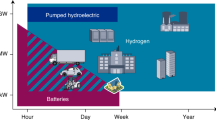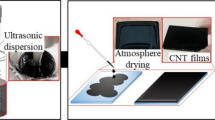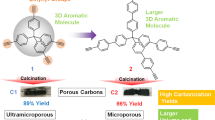Abstract
Pores of molecular dimensions can adsorb large quantities of gases owing to the enhanced density of the adsorbed material inside the pores1, a consequence of the attractive potential of the pore walls. Pederson and Broughton have suggested2 that carbon nanotubes, which have diameters of typically a few nanometres, should be able to draw up liquids by capillarity, and this effect has been seen for low-surface-tension liquids in large-diameter, multi-walled nanotubes3. Here we show that a gas can condense to high density inside narrow, single-walled nanotubes (SWNTs). Temperature-programmed desorption spectrosocopy shows that hydrogen will condense inside SWNTs under conditions that do not induce adsorption within a standard mesoporous activated carbon. The very high hydrogen uptake in these materials suggests that they might be effective as a hydrogen-storage material for fuel-cell electric vehicles.
This is a preview of subscription content, access via your institution
Access options
Subscribe to this journal
Receive 51 print issues and online access
$199.00 per year
only $3.90 per issue
Buy this article
- Purchase on Springer Link
- Instant access to full article PDF
Prices may be subject to local taxes which are calculated during checkout
Similar content being viewed by others
References
Gregg, S. J. & Sing, K. S. W. Adsorption, Surface Area and Porosity (Academic, London, 1982).
Pederson, M. R. & Broughton, J. Q. Nanocapillarity in fullerene tubules. Phys. Rev. Lett. 69, 2689–2692 (1992).
Dujardin, E., Ebbesen, T. W., Hiura, H. & Tanigaki, K. Capillarity and wetting of carbon nanotubes. Science 265, 1850–1852 (1994).
Bethune, D. S. et al. Cobalt-catalysed growth of carbon nanotubes with single-atomic-layer walls. Nature 363, 605–607 (1993).
Pace, E. L. & Siebert, A. R. Heat of adsorption of parahydrogen and orthodeuterium on graphon. J. Phys. Chem. 63, 1398–1400 (1959).
Bandosz, T. J., Jagiello, J., Amankwah, K. A. G. & Schwarz, J. A. Chemical and structural properties of clay minerals modified by inorganic and organic material. Clay Miner. 27, 435–444 (1992).
Schwarz, J. A. Final Report for the Tasks XC-1-1108-1 and XAE-3-13346-01 (National Renewable Energy Laboratory, Golden, Colorado, 1994).
Dillon, A. C., Bekkedahl, T. A., Cahill, A. F., Jones, K. M. & Heben, M. J. Carbon nanotube materials for hydrogen storage. Proc. 1995 U.S. DOE Hydrogen Program Review 521–541 (National Renewable Energy Laboratory, Golden, Colorado, 1995).
Madix, R. J. The application of flash desorption spectroscopy to chemical reactions on surfaces: Temperature programmed reaction spectroscopy. Chemistry and Physics of Solid Surfaces (ed. Vanselov, R.) 63–72 (CRC, Boca Raton, 1979).
Ibok, E. E. & Ollis, D. F. Temperature programmed desorption from porous catalysts: Shape index analysis. J. Catal. 66, 391–400 (1980).
Peterson, B. K. & Gubbins, K. E. Phase transitions in a cylindrical pore: Grand canonical Monte Carlo, mean field theory, and the Kelvin equation. Molec. Phys. 62, 215–226 (1987).
Ajayan, P. M. et al. Opening carbon nanotubes with oxygen and implications for filling. Nature 362, 522–525 (1993).
Tsang, S. C., Harris, P. J. F. & Green, M. L. H. Thinning and opening of carbon nanotubes by oxidation using carbon dioxide. Nature 362, 520–522 (1993).
Ernst, K. H., Schwarz, E. & Christmann, K. The interaction of hydrogen with a cobalt (1010) surface. J. Chem. Phys. 101, 5388–5401 (1994).
Lisowski, W. The kinetics of the low-temperature hydrogen interaction with polycrystalline cobalt films. Appl. Surf. Sci. 37, 272–282 (1989).
Nielsen, M., McTague, J. P. & Ellenson, W. Adsorbed layers of D2, H2, O2, and 3He on graphite studied by neutron scattering. J. Phys. 38, C4/10–C4/18 (1977).
DeLuchi, M. Hydrogen Fuel-Cell Vehicles (Institute of Transportation Studies, Univ. California, Davis, 1992).
DeLuchi, M. A. Hydrogen vehicles: An evaluation of fuel storage, performance, safety, environmental impacts, and cost. Int. J. Hydrogen Energy 14, 81–130 (1989).
T-Raissi, A. & Sadhu, A. Systems study of metal hydride storage requirements. Proc. 1994 DOE/NREL Hydrogen Program Review 85–106 (National Renewable Energy Laboratory, Golden, Colorado, 1994).
Thess, A. et al. Crystalline ropes of metallic carbon nanotubes. Science 273, 483–487 (1996).
Gordon, R. Composite pressure vessels for gaseous hydrogen-powered vehicles. Hydrogen Energy Progress V (eds Veziroglu, T. N. Taylor, J. B.) 1225–1236 (Pergamon, New York, 1984).
Dresselhaus, M. S., Dresselhaus, G. & Saito, R. C60 related tubules. Solid State Commun. 84, 201–205 (1992).
Author information
Authors and Affiliations
Rights and permissions
About this article
Cite this article
Dillon, A., Jones, K., Bekkedahl, T. et al. Storage of hydrogen in single-walled carbon nanotubes. Nature 386, 377–379 (1997). https://doi.org/10.1038/386377a0
Received:
Accepted:
Issue Date:
DOI: https://doi.org/10.1038/386377a0
This article is cited by
-
Nanomaterials: paving the way for the hydrogen energy frontier
Discover Nano (2024)
-
Graphene quantum dots blocking the channel egresses of cytochrome P450 enzyme (CYP3A4) reveals potential toxicity
Scientific Reports (2023)
-
Chemisorption solid materials for hydrogen storage near ambient temperature: a review
Frontiers in Energy (2023)
-
A novel type microporous adsorbent based on single-walled carbon nanotubes assembled by toluene molecules for methane storage
Adsorption (2023)
-
Properties, assembly and characterization of carbon nanotubes: their application in water purification, environmental pollution control and biomedicines—a comprehensive review
Carbon Letters (2023)
Comments
By submitting a comment you agree to abide by our Terms and Community Guidelines. If you find something abusive or that does not comply with our terms or guidelines please flag it as inappropriate.



